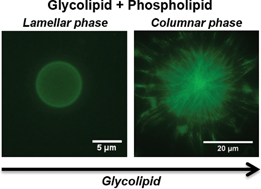Adding glycolipid functionality to model membranes – phase behaviour of a synthetic glycolipid in a phospholipid membrane†
Abstract
Glycolipid phase behaviour is less well understood than for many phospholipids, but due to their structural and functional diversity, glycolipids represent an important group of amphiphiles from which biological function is derived. Here we have incorporated a synthetic glycolipid in binary mixtures with DOPC (1,2-dioleoyl-sn-glycero-3-phosphocholine) into giant unilamellar vesicles (GUVs) at biologically relevant concentrations and observed the phase behaviour of the lipid mixtures for a range of glycolipid concentrations. At low concentrations, the glycolipid is fully dispersed in the GUV membrane. At glycolipid molar concentrations above 10%, the formation of lipid tubules is observed, and is consistent with the formation of a columnar lipid phase. Lipid tubules are observed in aqueous and oil solvents, suggesting that both hexagonal and inverted hexagonal lipid arrangements can be formed. This work may offer insights into the biological function of glycolipids and the challenges in formulating them for use in industrial applications.


 Please wait while we load your content...
Please wait while we load your content...